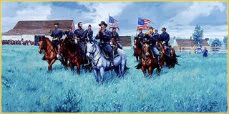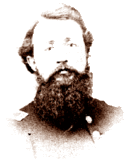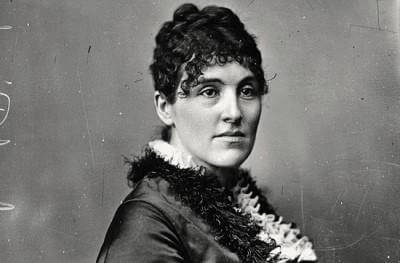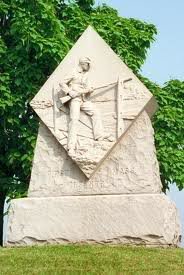Civil War Nurse at Gettysburg
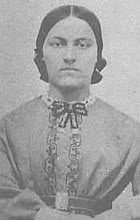 Elizabeth Salome ‘Sallie’ Myers was born at Gettysburg, Pennsylvania on June 24, 1842, the daughter of Peter and Mary Myers. Her father was a Justice of the Peace, and they were among the wealthier families in town. By 1863 Gettysburg was a thriving little community with 2,400 inhabitants, 190 of them African Americans.
Elizabeth Salome ‘Sallie’ Myers was born at Gettysburg, Pennsylvania on June 24, 1842, the daughter of Peter and Mary Myers. Her father was a Justice of the Peace, and they were among the wealthier families in town. By 1863 Gettysburg was a thriving little community with 2,400 inhabitants, 190 of them African Americans.
At the age of sixteen Sallie became a school teacher. In 1863 she was employed by the Gettysburg public school system as an assistant to the principal, and was still living with her family on West High Street. Sallie was in her fourth week of summer vacation from her teaching job, and had recently celebrated her 21st birthday when fighting broke out west of town on the morning of July 1, 1863.
Sallie Myers’ diary was published as How A Gettysburg Schoolteacher Spent Her Vacation in 1863 in The Sunday Call newspaper in San Francisco, California in the summer of 1903. She wrote in her diary:
Of the experiences of the inhabitants of the Southern border counties of our state that Spring and Summer, I need not speak. Business of all kinds was paralyzed and the daily reports of the coming of the rebels kept us in a constant fever of excitement. On June 26 they came, spent the night and passed through… burning bridges and spreading consternation everywhere. Little we dreamed of the far greater horrors that were in store for us.
The three-day battle at Gettysburg was fought on farms owned by private citizens that surrounded the crossroads town; it was considered the turning point of the Civil War. General Robert E. Lee’s Army Of Northern Virginia, consisting of 75,000 men and the 97,000 men of the Army of the Potomac led by General George G. Meade met by chance when a Confederate brigade observed a column of Union cavalry.
On the morning of July 1, advance units of these two opposing forces came into contact with one another west of Gettysburg. The sounds of battle attracted other units, and by noon the conflict was raging. During the first hours of the engagement, Union General John Reynolds was killed with a bullet through the base of his skull, and the Yankees found that they were outnumbered. The battle lines were drawn around the northwestern rim of Gettysburg.
Sallie wrote in her diary:
On Wednesday July 1, the storm broke. We were brimming over with patriotic enthusiasm. While our elders prepared food, we girls stood on the corner near our house and gave refreshments of all kinds to ‘our boys’ of the First Corps, who were double-quicking down Washington Street to join the troops already engaged in battle west of the town. After the men had all passed, we sat on our doorsteps or stood around in groups, frightened nearly out of our wits but never dreaming of defeat.
At 10 o’clock that morning I saw the first blood. A horse was led past our house covered with blood. The sight sickened me. Then three men came up the street. The middle one could barely walk. His head had been hastily bandaged and blood was visible. I grew faint with horror. I had never been able to stand the sight of blood, but I was destined to become used to it.
Confederate General Robert E. Lee arrived in Gettysburg by mid-afternoon. Shortly thereafter the Rebels drove the Yankees in a pell-mell retreat through the town. Sallie wrote:
Then came the order: ‘Women and children to the cellars; the rebels will shell the town.’ We lost little time in obeying the order. My home was on West High Street, near Washington [Street] and in the direct path of the retreat [of the Union Army]. From 4 to 6 we were in the cellar and those two hours I can never forget. Our cellar was a good one and furnished a refuge for many besides our own family.
We knelt, shivering, and prayed. The noise above our heads and from the distance, the rattle of musketry, the screeching of shells, and the unearthly cries, mingled with the sobbing of the children shook our hearts. Three soldiers crept down into the cellar, and we concealed and fed them.
After the Rebels had gained full possession of the town, some of our men who had been captured were standing near the cellar window. One of them asked if some of us would take their addresses and the addresses of friends and write to them of their capture. I took thirteen and wrote as they requested. I received answers from all but one, and several of the soldiers revisited the place of their capture and recognized the house and cellar window.
By evening, the Federal troops rallied on high ground on the southeastern edge of Gettysburg. As more troops arrived, Meade’s army formed a three-mile long, fishhook-shaped line running from Culp’s Hill on the right flank, along Cemetery Hill and Cemetery Ridge, to the base of Little Round Top. The Confederates held Gettysburg, and stretched along a six-mile arc around the Union position.
Sallie wrote:
Before 6 o’clock the firing ceased and we came up from the cellar. They had begun bringing wounded and injured into town. The Catholic and Presbyterian churches, a few doors east of my father’s home were taken possession of as hospitals.
Dr. James Fulton [143rd Pennsylvania Volunteers] did splendid work getting things in shape. From that time on we had no rest for weeks. ‘Girls,’ Dr. Fulton said, ‘you must come up to the churches and help us – the boys are suffering terribly! I went to the Catholic church. On pews and floors men lay, the groans of the suffering and dying were heartrending. From that time on we had no rest for weeks.
I knelt beside the first man near the door and asked what I could do. ‘Nothing,’ he replied, ‘I am going to die.’ I went outside the church and cried. I returned and spoke to the man – he was wounded in the lungs and spine, and there was not the slightest hope for him. The man was Sgt. Alexander Stewart of the 149th Pennsylvania Volunteers. I read a chapter of the Bible to him; it was the last chapter his father had read before he left home.
The passage Sallie read to Stewart was the fourteenth chapter of John: “Peace I leave with you. In my Father’s house are many mansions: if it were not so, I would have told you. I go to prepare a place for you… Let not your heart be troubled, neither let it be afraid.” She then had Stewart moved to her home, a few doors down the street, and cared for him until his death on Monday, July 6.
The sight of blood never again affected me, and I was among wounded and dying men day and night. While the battle lasted and the town was in possession of the Rebels, I went back and forth between my home and the hospitals without fear. The soldiers called me brave, but I am afraid the truth was that I did not know enough to be afraid and if I had known enough, I had no time to think of the risk I ran, for my heart and hands were full.
After the fighting Sallie Myers continued nursing at the general hospital that was located in Wible’s woods, caring for patients until they were well enough to be moved to Camp Letterman, the large Union field hospital on the York Road east of Gettysburg.
I went daily through the hospitals with my writing materials, reading and answering letters. This work enlisted all my sympathies, and I received many kind and appreciative letters from those who could not come. Besides caring for the wounded, we did all we could for the comfort of friends who came to look after their loved ones.
I would not care to live that summer again, yet I would not willingly erase that chapter from my life’s experience; and I shall always be thankful that I was permitted to minister to the wants and soothe the last hours of some of the brave men who lay suffering and dying for the dear old flag.
The aftermath of the Battle of Gettysburg was in many ways worse than the battle itself. People came out of their homes on Independence Day. The armies were leaving, but the wounded and dead remained, on fields, in houses, in barns and in hospital tents – 21,000 wounded, perhaps 10,000 dead. Disinfectant powder was spread over the muddy streets, temporarily turning them white and adding to the smell.
In an attempt to control disease, kerosene was poured on the bodies of horses and mules – 3000 to 5000 of them – and they were set ablaze. The odor of burning flesh dissipated after a while, but the smell of rotting carcasses would remain for months. The July days and nights were stiflingly hot, but windows were left closed to keep out the stench.
In late July, Sallie received a letter from Alexander Stewart’s younger brother Henry, who was a minister. The following summer, Henry and his mother came to Gettysburg. A romance developed between Sallie and Henry, and they married in 1867. Their marriage was brief, however; Henry died in the fall of 1868 from the effects of wounds received during the war.
In February 1869, Sallie gave birth to her only child, a son she named Henry Alexander Stewart, who became a physician and was one of the founders of Gettysburg’s Annie Warner Hospital. He was also a local historian, and helped to establish the Adams County Historical Society. He had the foresight to make typed copies of his mother’s diaries, preserving a wonderful source of the history she lived.
To support herself and her infant son, Sallie returned to teaching and continued in this position until about 1905. She became involved with the National Association of Army Nurses, and served as its treasurer for twenty years, in recognition of her activity in nursing wounded soldiers during the Battle of Gettysburg.
Sallie Myers Stewart died of pneumonia on January 16, 1922 at age 79 and was buried in Evergreen Cemetery on Cemetery Hill in Gettysburg.
SOURCES
Civil War Sources: Salome “Sallie” Myers
Gettysburg: The Civil War’s Costliest Battle
Thomas Legion: Civilian at the Battle of Gettyburg
Persephone in the River Phlegethon; or, the Women at Gettysburg – PDF
